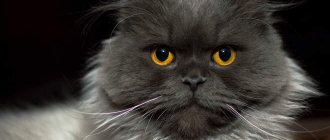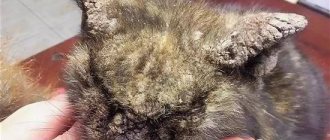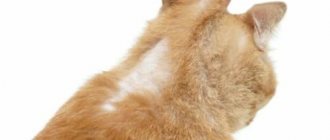- The role of the liver in cats
- Visually detectable signs of liver disease in a cat
- The most dangerous liver diseases of cats by class, symptoms and treatment methods
- Cirrhosis
- Hepatosis
- Cholecystitis
The most common liver diseases in cats
The cat's liver is a powerful biological filtering station, which is responsible for neutralizing substances harmful to the body that enter with food, air, and drink.
The role of the liver in cats
Passing through it, through the action of special cleansing enzymes, a completely healthy secretion of useful substances enters the blood and organs. This hardworking organ is also responsible for the synthesis of proteins and hormones, and is also a strong immune stimulant.
Most harmful substances - allergens, chemicals, various toxins from the air and food undergo thorough cleaning in the liver, causing more and more damage to it each time. Malfunctions in the work of the body’s main “cleaner” affect the functioning of vital organs, and at the same time a favorable atmosphere is created for the development of serious diseases:
- Gallstone disease;
- Cirrhosis;
- Hepatitis A;
- Cholecystitis;
- Neutrophilic and lymphocytic cholangitis;
- Lipidosis;
- Liver failure;
- Amyloidosis
Everyone knows that the liver has an amazing self-healing function, but it should be understood that the process is very long, labor-intensive and requires a professional approach. Therefore, it would be wiser not to delay at the first sign of a malfunction in the liver of cats and contact a veterinary clinic.
Every owner should remember that if their beloved pets refuse even a tasty morsel offered to them, most likely this is a manifestation of liver disease in cats, symptoms and treatment for which a certified veterinarian can recognize and prescribe.
For a more detailed understanding of the symptoms and consequences of the most common liver diseases, as well as possible treatment methods, owners will be given the information below.
Liver tumors
Tumors are rare in cats. However, they are most often malignant. Among liver tumors, bile duct cancer ranks first, followed by carcinoid and sarcoma.
Benign neoplasms include hepatic cell adenoma, hemangioma, hepatoma and leiomyoma. Bile duct cystadenoma is the most common tumor in cats.
Benign tumors usually do not cause any discomfort to a cat and do not cause the development of disease, however, until they grow or rupture, causing bleeding in the cat.
Visually detectable signs of liver disease in a cat
In veterinary practice, there are several main symptoms, upon detection of which the owner can be sure that this is inflammation of the liver in cats, and there is no need to hesitate:
- Failure to defecate, with frequent diarrhea or constipation;
- Vomit;
- Yellowness of the skin;
- Dark brown coloration of urine;
- Exhaustion and thinness;
- Severe bloating;
- Refusal of food;
- Increased change in liver size;
- Sharp or stabbing pain;
- Apathy and powerlessness;
- Rupture of blood capillaries, which is clearly visible on the skin;
- Poor blood clotting;
- The appearance of a feverish state
Based on the above signs, the owner can independently suspect liver disease in cats, the treatment of which should be entrusted to the hands of qualified specialists.
Ask your veterinarian:
- What foods should I not give my cat due to her health condition?
- How can human food affect a cat's health, you ask?
- Would you recommend Hill's Prescription Diet for my cat?
- Ask about special foods for your cat.
- How much and how many times per day should you feed your cat the recommended food?
- Discuss what treats you can give your cat with the recommended food.
- How quickly will my cat show signs of improvement?
- Can you provide me with written instructions or a brochure with information about the liver disease my cat has been diagnosed with?
- What is the best way to contact you or your veterinary practice if I have questions (email/phone)?
- Ask if your cat needs follow-up care.
- Please confirm whether you will be sent a reminder letter or an email notification.
Cirrhosis
This disease can be easily detected by lightly stroking the pet's belly. If there is growth in the abdominal cavity, this is a signal of a serious liver disease - cirrhosis, leading to changes in the organ up to its decomposition in the future. Symptoms of the development of the disease manifest themselves in certain signs:
- Conjunctiva with red spots;
- Diarrhea;
- Refusal of food;
- Yellowness of the skin;
- Organ enlargement;
- Rapid breathing;
- Arrhythmia
The development of cirrhosis in cats can be facilitated by a sedentary lifestyle, lack of vitamin B and protein, infestations, and the consequences of a previous disease. In addition, a stimulator for the development of cirrhosis can be the ingestion of various toxins into the body, for example, from low-quality food.
Only a doctor can correctly prescribe medications for liver treatment in cats, which are selected according to the established diagnosis. In this case, the veterinarian will determine drug therapy followed by a rehabilitation period.
Importance of Nutrition
If your cat has been diagnosed with liver disease, you're probably wondering, "How to care for her?" Treatment of any liver disease is aimed at giving the liver “rest” and minimizing its load, which is associated with the processing of fats, proteins, carbohydrates and medications. It is especially important to feed the cat correctly. Give her a diet with easily digestible carbohydrates, high-quality fats, and limited salt to control existing liver damage and improve liver function.
For an accurate diagnosis and proper treatment, always consult your veterinarian and ask for recommendations on the best food for your pet's liver health.
Hepatosis
The second most severe disease is hepatosis in cats, symptoms and treatment, which is determined strictly after a thorough examination. According to symptoms, there are several main signs:
- When the eyelid is pulled upward, the visible yellowness of the membrane is smoothed;
- What is typical for the skin of the lower lip and gums
The cause of the disease is determined by the ingestion of toxinogenic substances into the body - drugs, poisons, allergens - the accumulation of which in the blood ensures the development of hepatosis.
When a veterinarian makes such a diagnosis, they are prescribed comprehensive treatment. If the cat’s condition is mild, then it is possible to undergo treatment at home, but with strict adherence to all doctor’s instructions.
Diagnostics
Diagnosis of liver failure in cats involves a wide range of tests, but the first step is to obtain a detailed history. To confirm the diagnosis, a general examination of the animal and palpation is used. A study is carried out of general clinical and biochemical blood tests, ultrasound of the abdominal cavity. If ascites is present, the fluid is diagnosed, its cytological composition, biochemical examination, and, if necessary, culture.
Cholecystitis
If a veterinarian identifies cholecystitis in cats, treatment will also be required for the inflamed gallbladder, the normal functioning of which directly depends on a healthy liver. The symptoms of the disease are acute and debilitating and manifest as:
- Alternating frequent diarrhea with constipation;
- Severe pain;
- Increased body temperature
The main stimulators of the development of cholecystitis are liver damage by lamblia and cholelithiasis. When contacting a veterinary clinic, drug treatment for the liver in cats will be prescribed, medications and a course of physiotherapy.
These are the most common liver diseases in cats, symptoms and treatment, which will help owners promptly recognize the disease and take their pet to a veterinary clinic. Remember, delay can cost your pet’s life and it’s not worth the risk.
Causes of diseases
What could cause harm to this most patient, hardworking, and therefore precious organ? Perhaps, just because of two circumstances that... are completely avoidable:
- poor quality nutrition (fatty and smoked foods, mold);
- the presence of parasites and infections in the body.
A malfunction occurs in the circulatory system if the liver eventually becomes ill with these ailments:
- hepatitis;
- cirrhosis;
- cholangitis;
- lipidosis;
- poisoning;
- oncology;
- liver failure.
A scary list, isn't it?
What to do?
Don't despair! All these diseases respond well to treatment, which is associated with a simply amazing ability to regenerate! The main thing is not to miss the symptoms and start treatment on time so that your beloved animal suffers less and brings you joy for many, many years to come.
It is important to remember that a specialist must make a diagnosis and prescribe treatment, and in the future you will be able to treat your pet yourself.
The only exceptions may be surgical intervention and some procedures.
We will pay special attention to older cats and those suffering from varying degrees of obesity. After all, it is among this category of animals that liver failure is common!
Experts do not recognize this disease as a separate one, considering it just... a dysfunction of the liver.
The main reason for the development of pathology is old age and obesity (it is often caused by castration of a cat, and not just excess nutrition and inactivity).
Two types of deficiency
Acute form.
In addition to the listed symptoms, the pet may have mental disorders. The cat is constantly tormented by bouts of vomiting and is disoriented. This is a sad picture, and if you do not seek veterinary help in time, the animal will go into shock. In most cases, the acute form of liver failure is easily treatable, but this requires hospitalization.
Chronic form.
In this case, the process lasts several months and it is more difficult to save it.
What can I advise you, dear friends?
Predisposition
Portosystemic shunts are usually diagnosed in young dogs; in adults they are diagnosed in the presence of concomitant liver diseases. The disease is more common among representatives of the following breeds: Yorkshire terrier, Maltese, Irish wolfhound, dachshund, miniature schnauzers, Australian shepherd.
Non-cirrhotic portal hypertension occurs in Doberman Pinschers.
Chronic hepatitis is common among dogs of the West Highland White Terrier, Cocker Spaniel, and Doberman Pinscher breeds.
Abnormalities in copper metabolism in the liver have been observed in Bedlington Terriers.
Treatment
One of the main ways to treat encephalopathy (reduce clinical manifestations) is to control the level of urea and the formation of ammonia from it in the intestines. A low pH level (acidic environment) in the intestine inhibits the work of urease (an enzyme that breaks down metabolites into toxic products), reduces the microflora that produces this enzyme, and reduces the absorption of ammonia: most of it is converted to ammonium and excreted in the feces.
The next important factor for reducing ammonia synthesis is diet: changing the sources and amount of proteins helps suppress the work of ureases.
When treating pathology, a small amount of drugs in low doses is used.
Initial treatment
Initially, treatment should be aimed at restoring water-electrolyte and acid-base balance, and also, which is extremely important, at suppressing the synthesis and absorption of toxins in the gastrointestinal tract. The choice of remedies at the initial stage of treatment depends on the root cause of the pathology. If encephalopathy is associated with the presence of a portosystemic shunt, then surgery is indicated. Before surgical treatment, the animal must be stabilized with medication. In an acute crisis, a starvation diet is indicated. In the future, the animal must be fed little by little. Dairy products and plants should be used as a source of protein. For normal bowel movements, you should add water-soluble fiber to your diet.
Low protein commercial foods are available and can be recommended (hill sk/d, royal canine renal, etc.).
Also used in the treatment of hepatic encephalopathy are:
- Antibiotics (prescribed together with lactulose) - to suppress bacteria in the intestines that synthesize urease and thereby increase the concentration of toxic compounds in the gastrointestinal lumen.
- Lactulose (synthetic carbohydrate).
- Enemas to normalize bowel movements.
- Medicines to suppress bleeding in the gastrointestinal tract. Patients with this pathology are prone to the formation of ulcers in the gastrointestinal tract. The blood released during this process is a source of a significant amount of protein, from which ammonia is synthesized in the intestines. The faeces should be checked for the presence of parasites and a suitable anthelmintic should be used if necessary.
- Drugs to suppress vomiting: metoclopramide, ondansetron.
- Drugs for the relief of seizures. The animal's glucose and electrolyte levels (calcium, potassium, sodium) should be checked. All drugs require strict supervision by a veterinarian.
- Medicines to reduce intracranial pressure.
Maintenance therapy
Infusion therapy plays an important role in maintaining water and electrolyte balance. Dehydration (lack of fluid in the body) causes an increase in the concentration of urea in the blood, which leads to an exacerbation of the pathology (as excess urea enters the intestines, and ammonia is synthesized from it, which is absorbed into the blood.
If albumin levels are insufficient, blood plasma transfusion is recommended.











